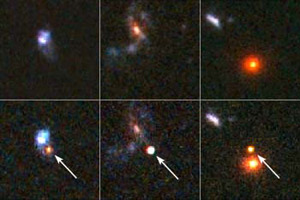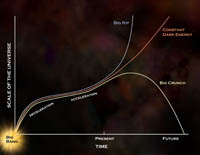Then vs. Now: Dark Energy
Ten Years Into a Runaway Universe
Ten years ago astronomers set out to measure how fast the Universe was expanding. The answer, they assumed, would determine what the fate of the Universe was.
NASA/STScI/G. Bacon
The question was 70 years in the making. In 1929 Edwin Hubble found that distant galaxies were racing away from us and that the Universe, long thought to be static, was ballooning outward. This observation, perhaps the most significant finding of the 20th century, agreed well with Albert Einstein's new theory, called general relativity. Scientists soon came to understand that the Universe was expanding from a "big bang."
Thus the key question that dominated the next several decades was whether the Universe would expand forever but at a slower and slower rate, pulled back by the force of gravity; or, if gravity were strong enough, would the Universe collapse inward into a "big crunch." This depended on the amount of matter in the Universe. Matter exerts a gravitational force, and if there were enough matter, the Universe would stop expanding and fall back in on itself.
By the mid-1990s astronomers were armed with sophisticated tools---the Hubble Space Telescope and large ground-based optical telescopes---to precisely determine the Universe's rate of expansion. Measuring the expansion rate gives the amount of matter in the Universe. From the amount of matter, the ultimate fate of the Universe can be determined. The answer they found in 1998 shocked everyone.
The Universe wasn't slowing down. It was speeding up. For 70 years, astronomers were asking the wrong question.

Two independent teams - the High-Z Supernova Search Team (headed by Adam Reiss) and the Supernova Cosmology Project (headed by Saul Perlmuter) - found that a group of star explosions called Type Ia supernovae were dimmer and therefore farther from Earth than expected. It was as if something moved the star explosions farther away from us. Scientists now call this mysterious force dark energy.
The discovery was utterly counterintuitive. Throw a ball up in the air; it falls back down. Imagine throwing a ball up in the air and, somehow, it kept going up faster and faster. That's what dark energy is doing to the Universe.
And the observations were no fluke. This force, working counter to gravity, has been confirmed independently by several different methods. In its study of fluctuations in the cosmic microwave background, NASA's Wilkinson Microwave Anisotropy Probe had determined that Universe is flat. This necessitates a total density of mass and energy in the Universe to be near the critical density. Since matter makes up only 26% of the Universe (4% in ordinary matter and 22% in dark matter) most of the Universe must be in another form of energy. So whatever dark energy is, there's a lot of it!
Another method to measure the expansion rate entails the study of massive clusters of galaxies with X-ray telescopes. The movement of hot gas within these clusters also reveals distances and velocities. These observations also showed an acceleration in the expansion of the Universe and the necessity for a large amount of dark energy.
Probing Dark Energy
The first step in understanding dark energy is to measure the expansion rate with even greater precision. New observations hint at the idea that the Universe's expansion was indeed slowing down about six billion years ago. The Universe was more compact then, and gravity was the dominant force. But as the Universe expanded, matter was distributed more thinly, and the collective attractive power of gravity grew weaker. Dark energy kicked in about six billion years ago and has been the dominant force ever since.
Scientists are now proposing space-based missions to study dark energy. The Joint Dark Energy Mission is planned as a collaboration between NASA and the Department of Energy, and is part of the Beyond Einstein Program. Three concepts are currently being studied: the Supernova/Acceleration Probe (SNAP) will detect distant supernovae to improve our knowledge of the history of the expansion of the Universe and utilize gravitational lensing observations to map the curvature of the Universe; the Dark Energy Space Telescope (Destiny) will detect supernovae in the near infra-red; the Joint Efficient Dark-Energy Investigation (JEDI) will look for distant supernovae, as well as look for baryonic oscillations from galaxy redshift survey. One of these concepts will be chosen to be built and launched.
A New Understanding of the Universe?
About 70% of the Earth is covered with water. Imagine not knowing what water is. That's the problem now facing scientists with the discovery of dark energy. Scientists admit that, although they have a few theories to explain it, they are years away from understanding what this force could be.
What excites scientists most about dark energy is that it reveals flaws in our current understanding of the Universe. As noted, just about everyone was surprised by its discovery. Understanding dark energy, scientists say, will lead to a new and deeper understanding of nature itself.
Scientists rely on two main theories to explain the workings of the Universe. There's Einstein's theory of general relativity, also known as the theory of gravity. This is used to describe the large-scale Universe. A separate theory called quantum mechanics---developed partially by Einstein but primarily by his contemporaries---describes the small-scale, or subatomic, forces: electro-magnetism (light), weak forces (seen in radioactivity) and strong forces (holding protons together).
General relativity and quantum mechanics, which are both powerful theories, do not mix with each other. Most scientists believe that there must be one unified theory to explain all of the Universe. Dark energy could serve as a bridge between the two dominant theories. Indeed, dark energy exhibits properties of general relativity and quantum mechanics.
The fate of the Universe remains far from understood. If dark energy continues its dominance in the Universe, every galaxy beyond our neighborhood of galaxies would fly so far away that it would no longer be visible.
The mystery of dark energy and the fate of the Universe will remain for many years to come, solved perhaps someday by a young reader of the Imagine the Universe website.
10th Anniversary Articles
Additional Links
- Read more about dark energy.
- Read more about the origin and destiny of the Universe.
- Read more about Beyond Einstein.
As part of the series, we also published a number of retrospectives on Imagine the Universe!
Publication Date: October 2006



